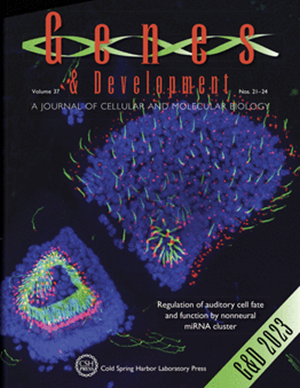转录因子SRF调节MERVL逆转录转座子和合子基因组激活过程中的基因表达
IF 7.7
1区 生物学
Q1 CELL BIOLOGY
引用次数: 0
摘要
细胞特异性转录程序的调控回路被认为受到转座元件(te)的影响,因此te作为包含顺式调控活性的遗传元件的多样化和全基因组分布的原材料。然而,在相关的生理背景下,TEs的转录激活因子在很大程度上是未知的。在这里,我们采用了一种进化方法来确定MERVL的两个主要家族的调节因子,MERVL是小鼠早期发育过程中的主要转录调节因子。结合系统调控、转录组学和功能缺失方法,我们证明了SRF是合子基因组激活过程中MERVL和胚胎转录的一种新型调节剂。通过解析两个主要MERVL家族的系统发育历史,我们描绘了SRF和DUX结合位点的进化获得,并表明SRF位点的获得先于DUX。SRF通过调控mervl参与胚胎转录,而mervl又作为宿主基因的启动子。我们的工作确定了在早期胚胎中形成基因表达程序的新的转录调控因子和TE,并强调了通过转录因子结合位点的顺序获取和与宿主的共同进化来驯化TE的过程。本文章由计算机程序翻译,如有差异,请以英文原文为准。
The transcription factor SRF regulates MERVL retrotransposons and gene expression during zygotic genome activation
The regulatory circuitry of cell-specific transcriptional programs is thought to be influenced by transposable elements (TEs), whereby TEs serve as raw material for the diversification and genome-wide distribution of genetic elements that contain cis-regulatory activity. However, the transcriptional activators of TEs in relevant physiological contexts are largely unknown. Here, we undertook an evolutionary approach to identify regulators of two main families of MERVL, a major regulator of transcription during early mouse development. Using a combination of phyloregulatory, transcriptomic, and loss-of-function approaches, we demonstrate that SRF is a novel regulator of MERVL and embryonic transcription during zygotic genome activation. By resolving the phylogenetic history of two major MERVL families, we delineate the evolutionary acquisition of SRF and DUX binding sites and show that the acquisition of the SRF site precedes that of DUX. SRF contributes to embryonic transcription through the regulation of MERVLs, which in turn serve as promoters for host genes. Our work identifies new transcriptional regulators and TEs that shape the gene expression programs in early embryos and highlights the process of TE domestication via the sequential acquisition of transcription factor binding sites and coevolution with the host.
求助全文
通过发布文献求助,成功后即可免费获取论文全文。
去求助
来源期刊

Genes & development
生物-发育生物学
CiteScore
17.50
自引率
1.90%
发文量
71
审稿时长
3-6 weeks
期刊介绍:
Genes & Development is a research journal published in association with The Genetics Society. It publishes high-quality research papers in the areas of molecular biology, molecular genetics, and related fields. The journal features various research formats including Research papers, short Research Communications, and Resource/Methodology papers.
Genes & Development has gained recognition and is considered as one of the Top Five Research Journals in the field of Molecular Biology and Genetics. It has an impressive Impact Factor of 12.89. The journal is ranked #2 among Developmental Biology research journals, #5 in Genetics and Heredity, and is among the Top 20 in Cell Biology (according to ISI Journal Citation Reports®, 2021).
 求助内容:
求助内容: 应助结果提醒方式:
应助结果提醒方式:


